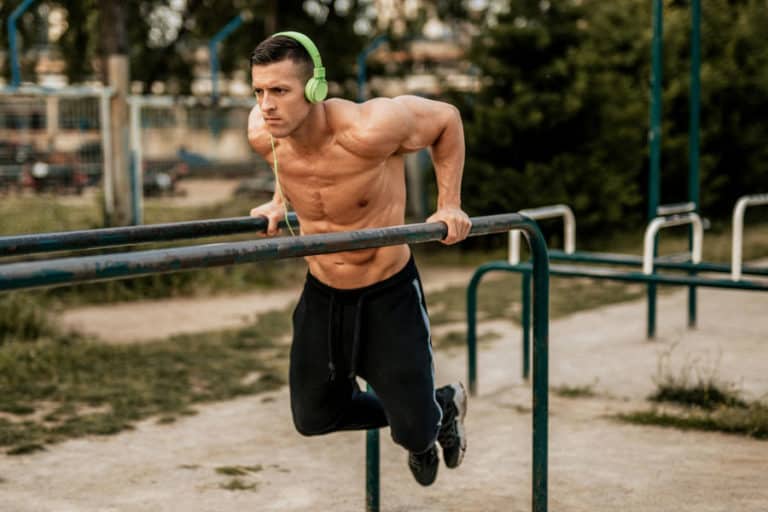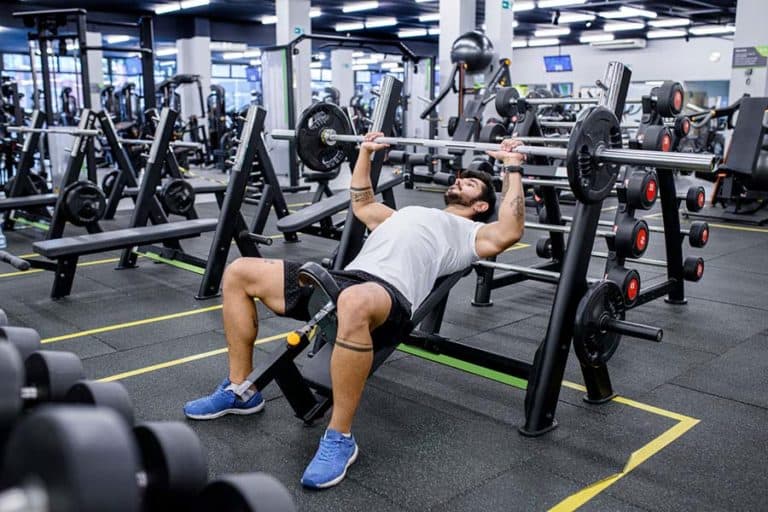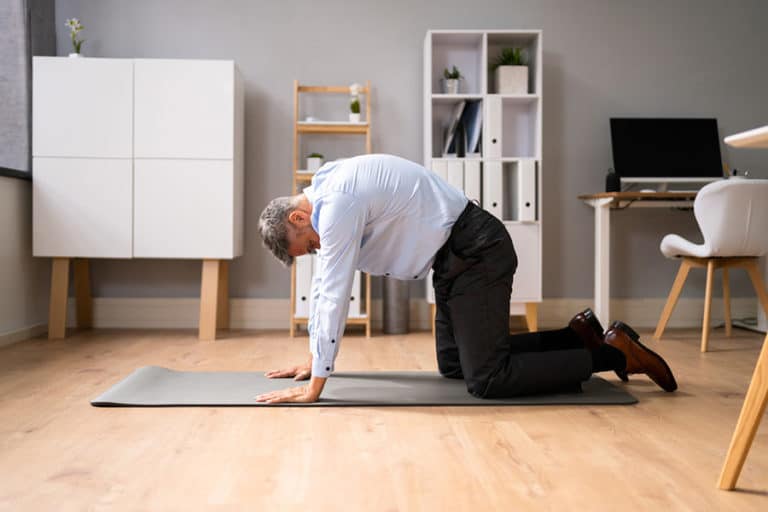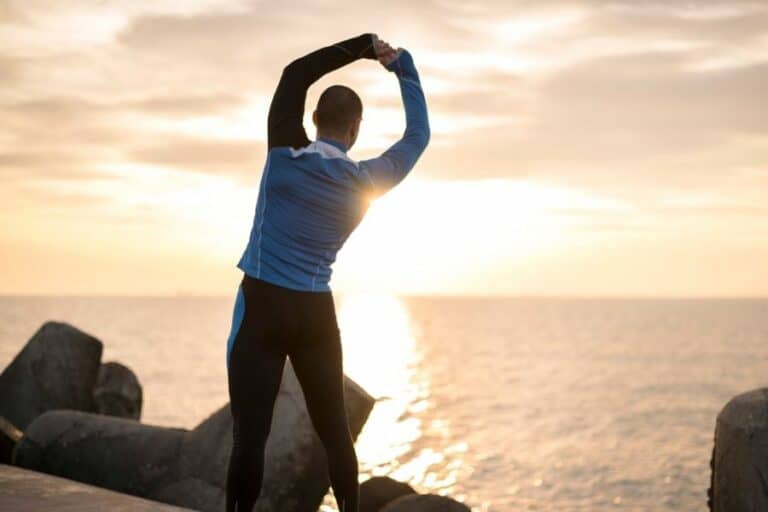In And Out Exercise – Techniques, Benefits, Variations
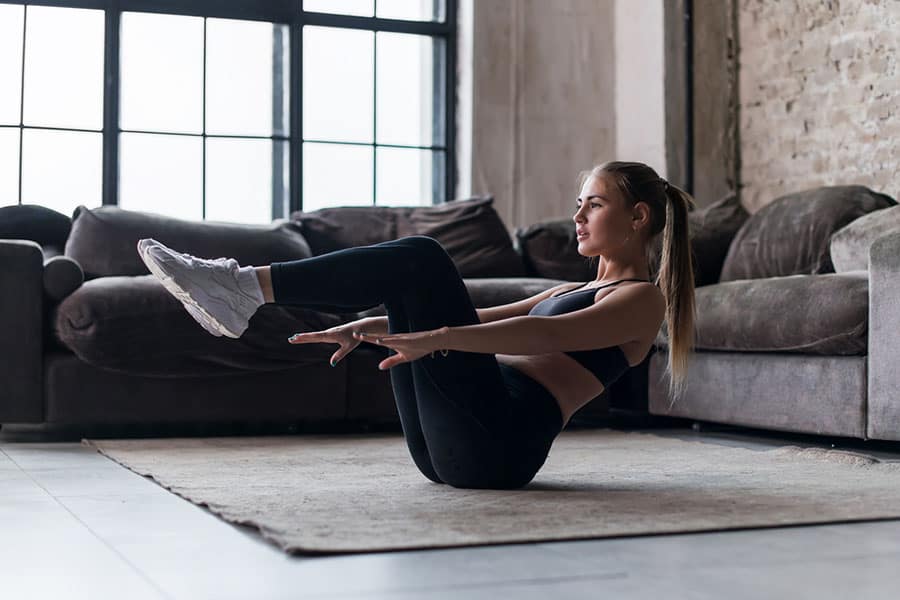
How To Do | Muscles worked | exercise Variations | Benefits | Drawbacks | Common Mistakes
The In and Out workout is an excellent ab workout. This movement targets the ab muscles, hip flexors and quadriceps while specifically isolating the abs.
This exercise can be done anywhere, anytime, without any equipment or weights. It’s perfect for those who want to strengthen their core muscles, improve their balance, and increase their flexibility.
What Are in and outs exercise?
In and outs exercises are a type of core exercise that targets the abs and hip flexors. They are also known as “V-ups” or “jackknife sit-ups.”
How to do the in and out exercise?
In and out exercises are basically a form of calisthenics (bodyweight exercises) and pilates exercises. In and outs are easy to perform since they do not require specific equipment or a lot of space. However, it is important to know how to execute a basic in and out exercise.
Here is a step-by-step guide to performing it:
- Start in a seated position, with a straight spine and legs slightly bent. Keep your arms beside your hips, in a wide arm position (only if you have the required balance), or behind your head for balance.
- Tighten your core, and pull your legs towards your chest. This is the ‘in’ position.
- Now gently start to lean back with a straight spine. Make sure your legs straighten out simultaneously, and your shoulder blades don’t touch the floor. Hold this position. This is your ‘out’ pose.
- Lift your torso back up and pull your legs into the ‘in’ position again. Make sure that your ab muscles are engaged throughout the move.
- Repeat this complete movement for a desired number of reps.
The below video includes a demonstration of the seated in and outs exercise. Incorporate this in and out abs movement into your fitness routine to experience steady progress. As you become more comfortable with the exercise, you may challenge yourself by incorporating more difficult variations of it.
Muscles worked in an in-and-out workout
If your fitness goal is to work your abs to become more defined and stronger, including your core, in and outs workout might just be perfect. However, know that it doesn’t work for all body goals.
For example, you shouldn’t expect to lose quickly as much body weight as other workouts that target weight loss. But if abs are your focus, you’ve got the right routine.
But is that all the in and out workout does? No, it’s more than that. This exercise targets your upper and lower body muscles.
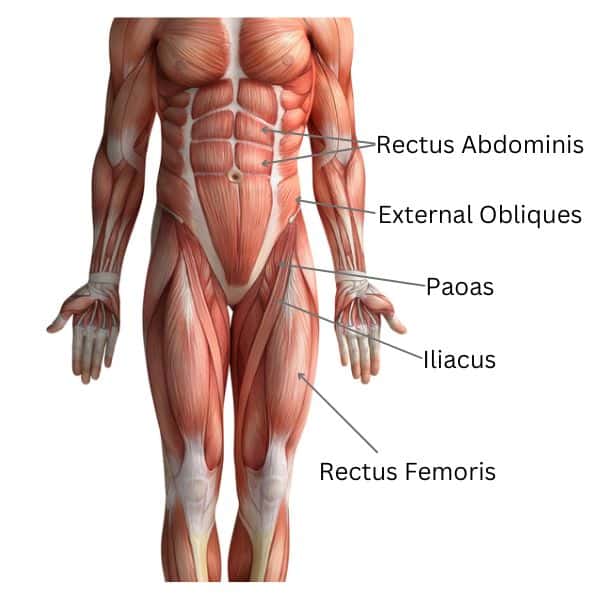
Rectus femoris
In and out exercise targets the rectus femoris, which is one of the quadriceps muscles. It is the middle muscle of the quadriceps and is responsible for knee extension. So, when doing an in and out exercise, your rectus femoris is working to extend your knee and raise your leg.
Rectus abdominis
It is a large, flat muscle in front of your abdomen. It comprises the upper abs and the lower abs. People can perform the in and out workouts primarily because of this muscle. It is the muscle that executes the movement during the routine.
The muscle divides into segments due to a tissue called the linea alba, giving your abdomen a six-pack appearance. This means you can get your six-pack body by doing the in and out workouts, provided that you are lean.
Obliques
These are your waist muscles, which help with the rotation and flexing of your spine. They help stabilize your movement when working out. However, you need to try certain variations of the in and out abs exercises to specifically target these muscles.
Transverse abdominis
Like the rectus abdominis, this muscle also is in front of your abdomen. However, the difference here is that the rectus abdominis runs vertically through the front of your abdomen while the transverse abdominis runs horizontally. This muscle helps to stabilize your spine by shrinking inward to create intra-abdominal pressure.
Iliacus and psoas major
Both commonly known as iliopsoas [1]National Library of Medicine: Anatomy, Bony Pelvis and Lower Limb, Iliopsoas Muscle, they flex your hips and stay active during your workout. These muscles are important for maintaining erect posture.
9 in and out exercise variations
Doing one type of workout routine every day can get boring. You may find it becoming monotonous and unchallenging with time. Don’t worry about it.
You can make the in and out workout routine more challenging with variations that’ll help you hit your goal regardless. Below are a few good core exercises that are in and out variations:
1. Bench in and out Crunch
Target muscles: Upper abs, lower abs, lower back, quads, and glutes
Equipment: Bench
How to do
- Sit on the edge of a flat bench. Extend your legs in front of you and place your heel on the floor.
- Lean backward and grip the sides of the bench for balance.
- Bend your legs and raise your knees inward towards you while leaning your torso forward.
- Stretch your legs out and lean backward to maintain balance.
- Continue reps.
Summary: This is similar to the regular in and out workout; the difference is that you’ll do this on a bench instead of the floor. This can be more comfortable, allowing you more room to change your body angle and help with more motion range.
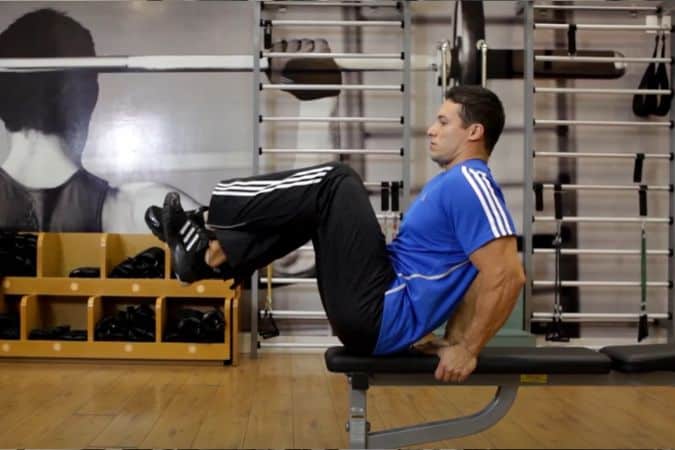
2. Reverse crunch
Target muscles: Rectus abdominis, hamstrings, psoas major, and glutes
Equipment: Not required
How to do
- Rest on your back on the ground and legs bent 90 degrees while keeping your thighs vertical.
- Lay your arms flat on the floor for balance.
- Flex your abs and raise your hips off the floor while curling your knees towards your shoulders.
- Make your movement slow and deliberate.
- Return to the starting point and repeat.
Summary: This is a simple bodyweight exercise which makes it ideal for home workouts. If you have issues with your back while doing basic in and outs, you can try reverse crunch as it helps your lower back. This is also great in and out abs exercise as it works your abs also without extending your hips.

3. Crunch Kicks
Target Muscles: Rectus abdominis
Equipment: Not required
How to do
- Start in a crunch position with your knees bent and feet flat on the floor.
- Raise your shoulders and upper back off the floor.
- Place your hands flat on your sides on the floor.
- As you exhale, lift your legs off the floor and bring your knees in towards your chest.
- At the same time, curl your upper body towards your raised knees.
- Inhale and return to the starting position.
Summary: For this in-and-out variation, you’ll be kicking two legs at a time as you crunch. This in and out core exercise is one of the simplest upper ab exercises. This is a great bodyweight exercise. You can try doing it with alternate legs.
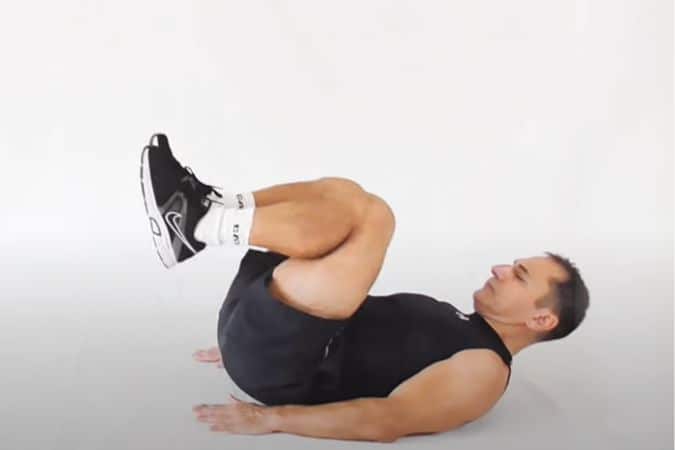
4. Bicycle crunch
Target muscles: Rectus abdominis and obliques
Equipment: Not required
How to do
- Rest on your back while keeping your legs straight, and place your hands behind your head.
- Clench your abs as you raise your legs off the floor a few inches. Flatten your lower back.
- Raise your upper body, bend one leg and pull your knee towards your chest.
- Lift your upper body and twist to let your elbow cross to meet your incoming knee.
- Stretch your other leg as you bend one.
- Repeat on the other side.
- Keep alternating sides.
Summary: The bicycle crunch is an abs exercise similar to the in and out crunches; the major difference is the leg and obliques movements. This can be easier on your lower back than the basic in and out. The best part of this in and out abs exercise is that it targets both lower and upper abs.

5. V sit-ups
Target muscles: Rectus abdominis, transverse abdominis, hip flexors and obliques
Equipment: Not required
How to do
- Lie on your back and extend your legs and arms straight, extending your arms above your head.
- Ensure you lift your head off the floor and press your knees together.
- Brace your abs and simultaneously raise your legs and upper back off the floor.
- Make sure your body balances on your lower back and butt and be in a v-like sitting position.
- Lower your legs and arms and repeat reps.
Summary: V sit-ups are highly advanced in and out abs exercises. This bodyweight exercise form involves moving your upper and lower body together. Although v sit-up workout primarily targets the abdominal muscles, it also works the arms, shoulders, and outer thighs.

6. Captain’s chair bent knee raise
Target muscles: Rectus abdominis and obliques
Equipment: Captain’s chair
How to do
- Get on the Captain’s chair, use your elbows to support your weight, and let your legs hang straight down.
- Press your shoulders back and down for stability and to protect your shoulder joints.
- Bend your legs and lift your knees until they’re above your hip height.
- Bring your legs back to the floor and repeat.
- You can also execute with a pull-up bar.
Summary: This variation of the in and out abs exercise is executed in a vertical position. Raise your back away from the pad to maximize abdominal recruitment. Your abs and hips flexors are primarily worked muscles. However, the target muscles are affected slightly differently.
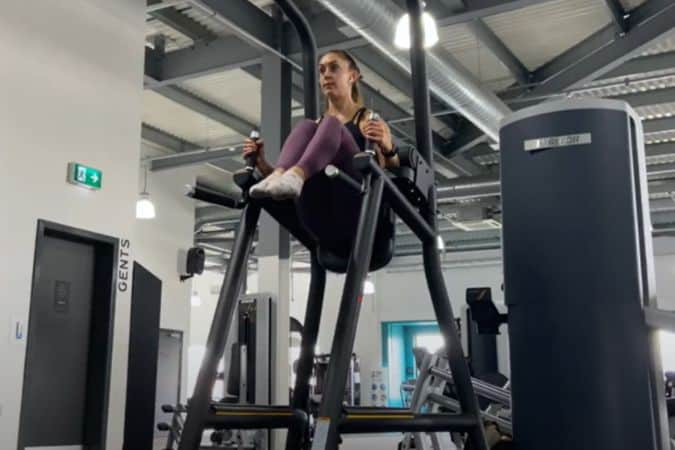
7. Abs wheel rollout
Target muscles: Rectus abdominis, obliques, erector spinae, latissimus dorsi, and shoulder muscles.
Equipment: Abs wheel
How to do
- Get in a kneeling position, and clutch an abs wheel with both hands.
- Keep your core steady and slide the abs wheel forward in a slow and controlled movement.
- Brace your abs and slide backward while using your hip flexors to raise your body.
- Go back to the starting position and repeat the steps.
Summary: The abs wheel rollout may not be an obvious variation of the in-and-out abs exercise. However, this exercise targets all the same muscles as other exercises. This exercise requires you to use your hip flexors and abs to lift your body rather than your legs.

8. Sit-up
Target muscles: Lower back, rectus abdominis, and hip flexors
Equipment: Not required
How to do
- Start in a sitting position.
- Then, lie down on your back on an exercise mat.
- Now, bend your knees.
- Place your hands behind your ears.
- Raise your torso to your thighs as close as possible.
- Lower your torso back to the floor.
- Repeat the sit-ups for a desired number of reps.
Summary: Sit-ups are a great form of in-and-out abs exercise to tone your midsection. This bodyweight exercise primarily targets the abdominal muscles. However, it also helps in strengthening the lower back and hip flexors.
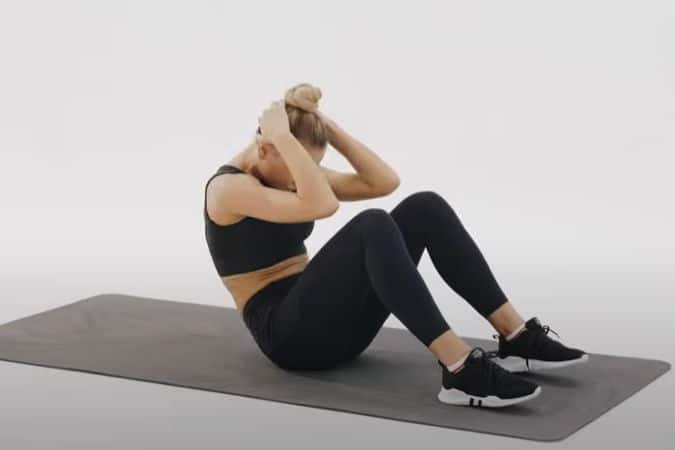
9. Elevated crunches
Target muscles: Upper abs, obliques, and calf muscles.
Equipment: Bench or a chair
How to do
- Rest on your back and place your feet on a bench or chair.
- Let your feet rest on the bench.
- Place your hands on the sides of your head and brace your abs.
- Raise your torso as close as possible to your thighs.
- Lower your torso back to the floor and repeat.
Summary: The elevated crunch in and out abs workout is a good way to switch up in and out exercise a notch higher. You’ll need to do this routine with a bench or chair to elevate your body.
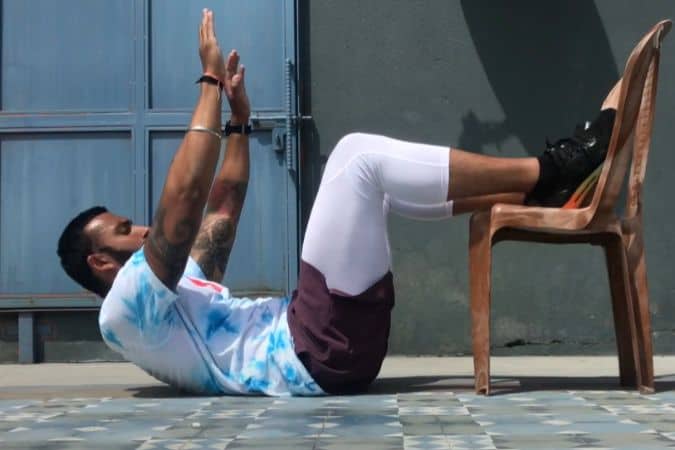
Benefits of in and out exercise
In and out abs exercise has many benefits other than toning your ab muscles. While your upper and lower abs and obliques tone up and strengthen, you will notice that in and out workouts can also:
- Help with weight loss.
- Help you build stronger muscles.
- Improve your mood.
- Help you get better sleep.
- Improve your balance and coordination.
- Help slow down aging.
- Reduce and prevent back pain and improve back strength [2]PubMed: Short-term effect of crunch exercise frequency on abdominal muscle endurance.
- Doesn’t require equipment or a strict location.
Drawbacks of in and out exercise
Like any other workout, in and out exercise also has drawbacks. While this type of workout is beneficial in many ways, some people may find it difficult to perform. Listed below are a few of the drawbacks of doing these exercises:
- It can be hard on body parts like your back, hip flexors, hips, and neck.
- Becomes less challenging with time.
- It can cause lower back strain.
- Without proper form, you can end up injuring yourself.
Note: Not suitable for people with certain health conditions like a hernia or dislocations.
Tips to perform in and out exercise correctly
Performing in and out exercises correctly is the key to ensuring the best results. Here are a few of the common mistakes to avoid in and out exercises:
- Warm up: Warm up before starting the workout. It is important to take your time with the exercise and get your muscles ready for the workout.
- Proper form: Maintain good form throughout. Do not round your back at any point while doing in and out exercises.
- Core engagement: Engage your core throughout the movement for better balance.
- Ground contact: Ensure that no part of your body touches the ground during the bottom of the “out” movement. Contact with the ground will cause disengagement of your core muscles.
- Hydration: Drink water regularly to keep your core temperature balanced.
- Recovery time: Give your body enough time for recovery. Don’t over-exert yourself, and take a break when you need to. Recovery is key to ensuring that you stick to the exercise in the long run.
Conclusion
If you want to start with easy ab exercises, you can try these in-and-out exercises. Besides toning your upper and lower abs, these exercises provide several other health benefits. If you want a little more challenge, try increasing difficulty and resistance using a weighted vest, resistance band, holding a plate, or using an abs wheel.
However, you have to be careful to prevent back pain or discomfort. Remember to warm up, drink water, and take breaks when needed. You are advised to maintain good form when exercising and check your balance. Add other variations to your fitness regime when you need to. Please note, if you have any health conditions, check with your doctor and plan a fitness program to ensure maximum safety.
References
| ↑1 | National Library of Medicine: Anatomy, Bony Pelvis and Lower Limb, Iliopsoas Muscle |
|---|---|
| ↑2 | PubMed: Short-term effect of crunch exercise frequency on abdominal muscle endurance |


